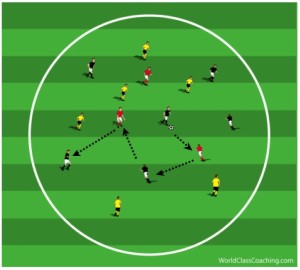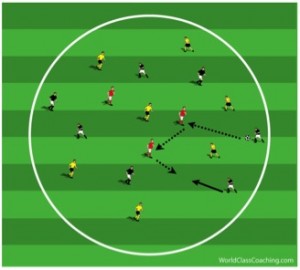Playing to Combine and Link Play
The principles of play within football continue to evolve and there is an emphasis on teams being able to retain possession and break down sides that are typically strong centrally. In any series of possession we are looking for options to either maintain possession or create an overload in order to gain an advantage to go forward and eventually score. Therefore, the movement, distances, awareness, decision-making, type of pass, number of touches amongst players is essential in order to breakdown, exploit and gain that advantage over the opposition. I have put together a series of progressive practices that challenge players and encourage them to link play. The sessions can apply to any situations in around the pitch where players combine and link to maintain possession and develop play.
Set Up
The group is split into two teams and 2or 3 players from each team in the middle of the circle with a ball each. The players on the outside are set up so they alternate yellow and black. The area can be a circle or a square and the size can be dependent on the type of passing and how much you wish to challenge your players with reducing the space.
1) Travel with the ball (4-5 touches), then play your pass to one of your teammates on the outside of the area and exchange places.
2) As above but looking to turn once or twice when traveling with the ball before passing the ball to the outside players.
3) When passing out combine with the player on the outside (play a one, two or take over etc,
4) Player on the outside receives the ball and before traveling through the circle plays a pass to receive the ball back with someone else on the outside
Progressions
• Limit the number of touches
• Reduce the size of area
• Introduce an area in the middle they are required to travel through
Coaching Points
• In possession play with head up (awareness of other players / space / where & who to play the ball to
• Quality with the touches and turn whilst in possession of the ball
• Decision made with the pass (how / where / when)
• Quality of final pass – type and weight of pass
• Receiving the ball – preparation prior to receiving the ball
• 1st touch in space (open out / take the ball off line)
• Chase 2nd touch
• Body shape when looking to combine
Relating to the Game
There will be a number of opportunities in the game when the space in front of a player opens up and they will have the opportunity to run with the ball. This could be in a transition phase when possession is won, and the opposition are out of shape and the space in front is there to be exploited. Other examples would be the full back over lapping in wide areas for a pass to be played into space for them to run onto, seeking an end product at the end of their run either a pass or a cross.
Relating the exercise to the game, specifically with the their first touch. As the receive the ball their first touch can be one that breaks the line (takes players out of the game) to then create an opportunity to run forward with the ball, but the direction, weight and acceleration to chase the 2nd touch are essential for this skill to be optimized.
Objective: Diagram 2
The next progression focuses on getting the spare player to find good areas to get on the ball. In doing this they have the option to either the link play with the player who has passed them the ball or take the ball and the two players exchange roles. This also encourages players to balance off and rotate.
Set Up
As with the previous exercise, but on 2 balls per team and 2 spare players in the middle. As above, but there is a spare player who the person on the ball can use to either to combine with or to take the ball away with and they then become the spare player
Progressions
• As above, but when playing to the outside player, exchange through combination
• Introduce a cross through the middle to divide the area in four areas and have player pass and receiving in a different area
• The spare player plays to the outside player and the other player links with the outside player
Coaching Points
• In possession play with head up (awareness of other players / space / where & who to play the ball to
• Decision made with the pass (how / where / when)
• Quality of final pass – type and weight of pass
• Receive the ball – preparation prior to receiving the ball
• 1st touch in space (open out / take the ball off line)
• Chase 2nd touch
• Body shape when looking to combine
• Spare playing looking to receive on angles
• Body shape prepared for next movement (open up – take on the back foot)
• Maintain good distances and players begin to balance off, recognizing the position of fellow players and space available
Objective: Diagram 3
To start working with the 3 players working together to link play and work the ball into good areas. Focusing on the principle of time and space, movement and the link between 3 and more players. With contextual interference. This could simulate 3 midfield players or midfield player, wide man and fullback are just a few examples.
Set Up
As with the previous exercise, but now each team only plays with 1 ball and the 3 players all have to touch the ball before it is played to the outside player and they switch positions.
Progressions
• As above, but when playing to the outside player, exchange through combination
• Introduce a cross through the middle to divide the area in four areas and have player pass and receiving in a different area
• Limit the amount of touches
• Create scenarios or conditions in the way in which players link, for example, the player who plays to the outside does not link, there is a 3rd man who combines with the outside and they then switch. You will then get a player supporting the pass made to the outside.
Coaching Points
• In possession play with head up (awareness of other players / space / where & who to play the ball to
• Decision made with the pass (how / where / when)
• Quality of final pass – type and weight of pass
• Receive the ball – preparation prior to receiving the ball
• 1st touch in space (open out / take the ball off line)
• Chase 2nd touch
• Body shape when looking to combine
• Spare playing looking to receive on angles
• Body shape prepared for next movement (open up – take on the back foot)
• Encourage players to run forward to trigger the pass
• Placement of pass, into path of player
• Ball set back is cue for player to run forward
• Various movements (3rd man running / rotational movement / over’s / jacks)
• Tempo of play
Relating to the Game
Within the game, in order to break down the opposition we are looking to some individual skill in key areas and also opportunities to create the overload in order to gain an advantage whether it would be in the build up or in the final 3rd to create a scoring opportunity.
Examples include when teams are looking to play out from the back, the overload will normally come from the deep lying midfield player who comes into deeper areas to help the centre backs work the ball out with the pressure of two attacking players. The goalkeeper is also available to use as an additional overload work the ball out. The midfield player dropping down, needs to time their movement and find a good area to receive the ball, knowing their next pass, therefore scanning and preparing body shape (ideally to open out and play forward).
If playing with a 3 in midfield against a two then naturally you will create an overload and the team needs to exploit that opportunity if they are able to work it in their favour.
Other examples include the player in the No.10 position dropping between the lines to get on the ball to link the play forward, playing passes into gaps behind there lines. The practice in Diagram 3 encourages the spare player to find good areas to receive the ball and either link the play or take the ball away, which forces a rotation and the next player becoming the spare player.
Objective: Diagram 4
The next stage is to implement within a possession game. Focusing on the link between 3 players, looking at creating that triangle that exists all over the pitch.
Set Up
Two teams (5 v 5 / v 6 / 7 v 7etc). With either 2 or 3 spare players. The way to score a point / goal is to play a pass into one of the spare men, who then plays it off to another member of your team successfully. The teams are on a restriction of 3 touches and the spare men, who play for both teams are on only 1 touch. If they play the ball back to the player who passed them the ball that is possession retained, but not a goal scored.
Progressions
• Reduce or increase the size of area
• Change the restriction on touches
Coaching Points
• Continuation of the coaching points made in previous sessions
• Spare player looking to find space, awareness of the next pass
• Provide options as the ball is traveling
• In possession make the pitch as big as a possible
• Out of possession good pressure on the ball
• Patient in possession
• Create and exploit the overload
• Communication
Objective: Diagram 5
As with the previous session the focus on players linking the play and players supporting in good areas, creating the overload
Set Up
As with the previous session, but a goal is scored when the two spare players link the play with players from the team in possession of the ball. For example, a player passes into the spare player, they must then pass to another spare player before returning to either the original player or a new player for a goal to be scored. The same touches apply 3 touch for the team and 1 touch for the spare players.
Progressions
• Reduce or increase the size of area
• Change the restriction on touches
Coaching Points
• Continuation of the coaching points made in previous sessions
• Spare player looking to find space, awareness of the next pass
• Provide options as the ball is traveling
• In possession make the pitch as big as a possible
• Out of possession good pressure on the ball
• Patient in possession
• Create and exploit the overload
• The spare players supporting each other, good supporting distances
• Communication
Relating to the Game
This session can used to work with the midfield three, if that is how you play or even three players combine playing out from the back, in wide areas and in around the box in the final third. Essentially it focuses on creating that triangle which provides passing lines and balance. The principle of players low, medium and high, encouraging them to pass on angles, run forward to receive the ball, breaking lines. Within this players are looking to create space for one another, which occurs all throughout the game, movement to come out of an area to enable another player to time their run to then come into that space.
Combinations are required to break teams down, especially in tight areas in and around the penalty box. This kind of session encourages clever play, with one-two’s, third man running, rotational movements and quick tempo of play.
In Summary
For me it is imperative that we challenge the players we are working with, stimulate them with problems which transfer into the game. Even when we are working with an unopposed skill practice, encourage them to make decisions, play with awareness with and without the ball. The practice in itself is repetitive, but has variation within it so players don’t get complicent. Instead that are always learning and contuning to develop the football intelligence which will assist them for the situatins that occure within the game. Ensure to create the right environment that will challenge your players at their stage of development and ability. For example, the size of area and the conditions you place on the session. One message I will leave you with which I think is the most important, but the players at the centre of your session / programme.






Leave a Reply